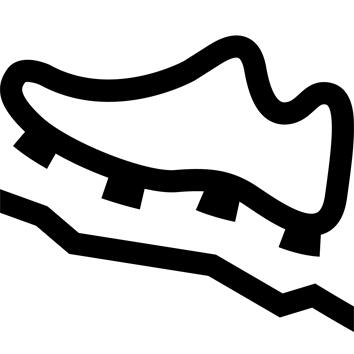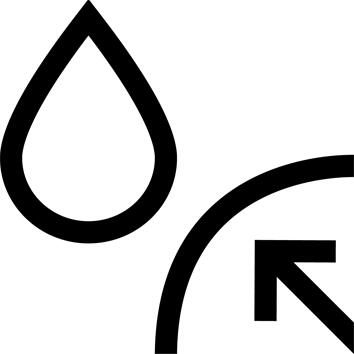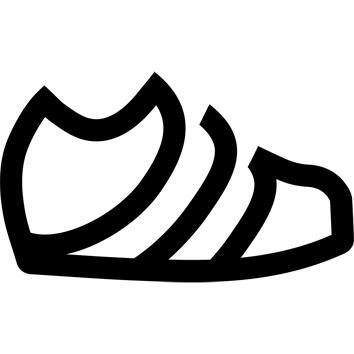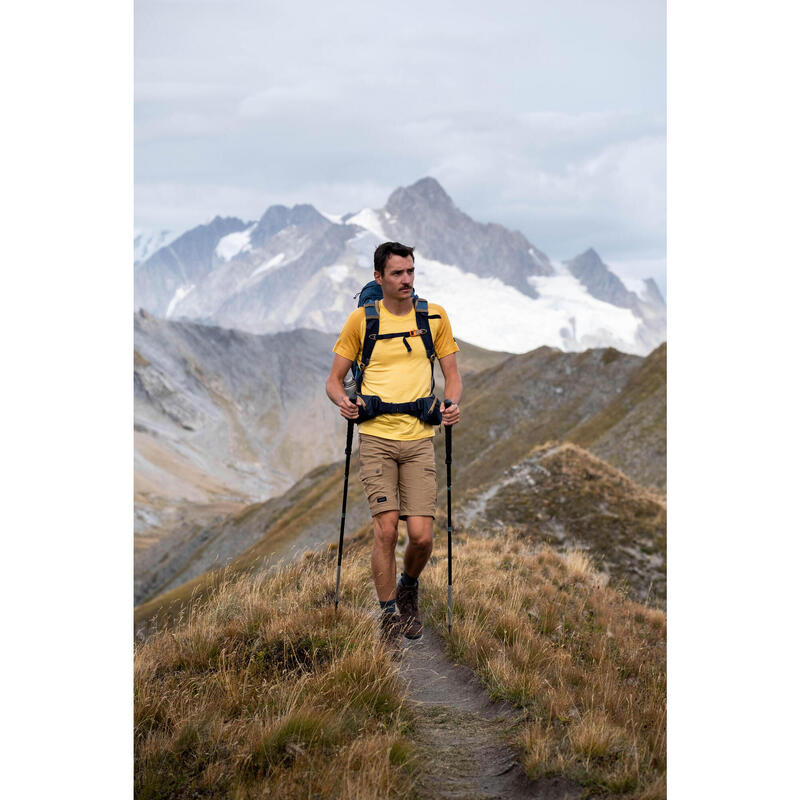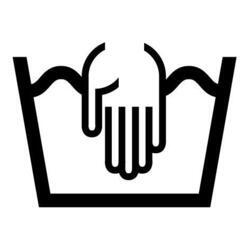European manufacturing 100% of our shoes Forclaz are made in Europe
These trekking boots are made in the European Union, in Romania, in a factory specialized in the production of trekking boots (Grisport)
This factory uses exclusively water-based glues, without chemical solvents.
The majority of materials are of European origin.
The type of course for this shoe
The program for this trekking shoe, the route generally taking place at a higher or lower altitude and/or on an all-terrain route, may be suitable for certain short passages that are a little more technical: passages over scree, névés, gradients, etc.
Advantages of the locking hook
It effectively dissociates the lacing of the lower and upper parts.
This allows you to adjust the lacing to the shape of your foot, giving your ankle more or less freedom. To lock this first tightening of the lower part, tie a simple knot at instep level, or use your shoe's blocker.
All our trekking shoes offer this possibility of dissociating lacing.
VIBRAM®. The grip and adherence of our soles
The grip of our soles is VIBRAM® certified.
In mid-mountain terrain, conditions and types of terrain can change rapidly.
The soles must be multi-purpose so that they can cope with stones, avoid slipping on these surfaces and also grip uphill and downhill slopes that have become muddy.
The design of the studs has been specifically developed in collaboration with our R&D team and VIBRAM's know-how.
Tested and approved!
The level of waterproofness of this shoe
This shoe has been waterproofed to 10,000 repeatable flexes, i.e. 15 km of walking in water up to mid-stem. This now guarantees a very good level of waterproofing for our shoes.
--> Our evaluation indicates a LEVEL OF 3/5, offering waterproofing for 6 hours of hiking in the rain.
Details of the tests carried out to evaluate the waterproofing of our shoes can be found a little further down.
Advantages and disadvantages of this leather model
Advantages:
- supple leather.
- resistant and waterproof, leather prevents water from penetrating the shoe by repelling and absorbing it.
- leather is breathable (natural pores in the leather skin), but less so than synthetic shoes in hot weather. To overcome this problem, use nubuck leather (for greater breathability, but also greater sensitivity to rain).
Disadvantages:
- it needs to be moisturized and treated to maintain its waterproofing properties.
Extend the waterproofing of this shoe. A question of accessories and a little elbow grease!
For leather, we recommend using a waterproof grease to nourish the leather, prevent it from drying out (cracking), WATERPROOF it and protect it from stains.
1/ TREKKING SHOES MAINTENANCE BRUSH
(code to be entered in the search bar: 8551990)
2/ WATERPROOFING GREASE FOR LEATHER SHOES
(code to be entered in the search bar: 8229704)
Increase the waterproofness of your footwear with a gaiter
Waterproof footwear is often compromised by the ingress of water through the top of the shoe.
--> To keep feet dry longer, use a waterproof gaiter or mini-gaiter to protect the top of the shoe from water ingress, as well as from stones and sand.
TREKKING Gaiter TREK 500 BLACK
(code to enter in search bar: 8347880)
Care for your leather shoes in 6 easy steps
1/ Remove the laces to avoid soiling them with grease.
2/ Dry-brush to remove dust and any particles stuck to the leather. This is essential to prevent the dirt from sticking to the leather with a new layer of grease.
3/ Grease the leather with a brush, so that the grease penetrates deep into all seams and gaps.
4/ Wipe off excess grease with a soft cloth.
5 /Gently rub to shine.
6/ Put the laces back on!
Waterproofing my leather shoes with a water-repellent reactivator
1/ Use a brush and/or sponge to clean the shoe and remove any residues of dirt or mud.
2/ Then leave to dry in the open air, away from a heat source.
3/ Finish with a water-repellent spray to keep the upper water-repellent and prolong the life of the shoe.
WATER RE-ACTIVATOR APPLICATOR FOR SHOES
(code to enter in the search bar: 8677748)
Choosing the right shoe size is a major challenge.
For hiking, don't hesitate to go one size larger than your usual shoe size, to ensure optimum comfort on the way down, and to prevent your toes from banging against the ground. Tip: keep your nails short and check that your lacing prevents your foot from slipping forward.
5 levels of waterproofing
In the waterproof test, we test 5 levels of waterproofness:
2,000 flexes (approx. 4 km, 30 min walk).
10,000 flexes (approx. 10 km, 3 hours' walking).
30,000 flexes (approx. 15 km, 6 hours' walking).
50,000 flexions (approx. 20 km, 8 hours' walking).
100,000 flexions (approx. >20 km, 24 hours' walking).
The waterproofing test carried out on this model
Our shoes are tested in the laboratory using 2 consecutive tests:
Test 1: We test the effectiveness of the membrane alone when immersed in water under air pressure. We simply check for the absence of bubbles at the surface, as with a punctured inner tube.
Test 2: Using a mechanical arm to simulate walking, the complete shoes are half immersed in water and flexed thousands of times to check that the inside of the shoe remains dry and therefore waterproof.
Try on your shoes step by step
To choose the right shoe:
1. Try on both shoes, standing, with the socks you use for hiking.
2. Tighten the laces correctly.
3. Check two important comfort points: the heel seat and the forefoot on descents.
4. Stand up to walk with your shoes on.
5. Try on several sizes and models.
6. Use your shoes gradually on the first few hikes to get them to fit your feet.
Main complementary laboratory tests
Laboratory tests are carried out to validate the following elements:
- hook and eyelet pull-out.
- sole bonding.
- toxicology.
- UV resistance.
- abrasion of sole and upper components.
- accelerated ageing.
